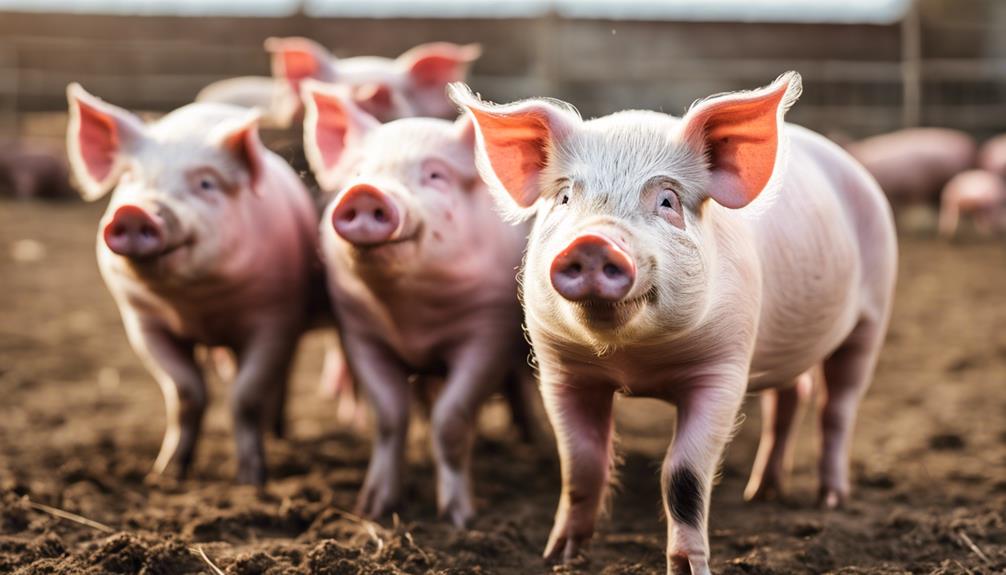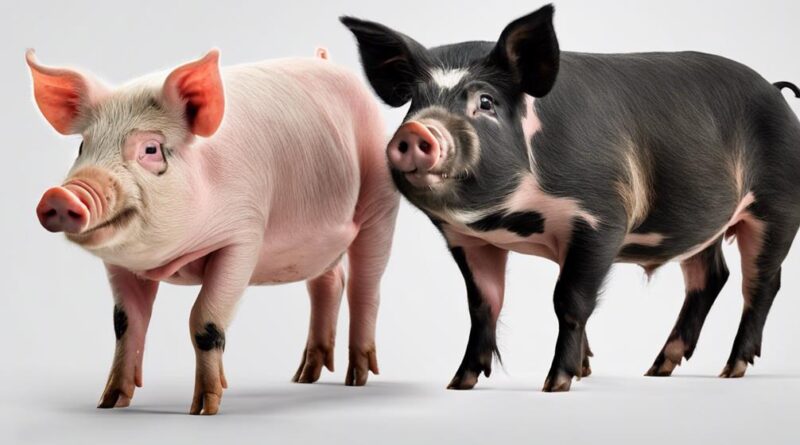Why Does Genetic Engineering Enhance Pig Breeds?
Have you ever wondered why genetic engineering plays a vital role in enhancing pig breeds?
The advancements in this field have led to significant improvements in various aspects of pig farming.
From disease resistance to tailored breeds for specific environments, genetic engineering offers a range of benefits that are reshaping the industry.
But why exactly does it hold such promise for the future of pig breeding?
Let's explore the key reasons behind the growing influence of genetic engineering on pig breeds.
Genetic Modification for Disease Resistance
To enhance disease resistance in pigs, genetic modification techniques are utilized. By introducing specific genes into pig breeds, scientists can bolster their immune systems, making them more resilient to various illnesses. However, this advancement raises ethical implications and regulatory concerns regarding the manipulation of animal genetics. Critics argue that altering the genetic makeup of pigs may disrupt the natural order and lead to unforeseen consequences within the ecosystem.
Despite the potential benefits of disease-resistant pigs, consumer acceptance and public perception play a significant role in the adoption of genetically modified breeds. Some consumers may have reservations about consuming products from genetically modified animals due to concerns about food safety and environmental impact. Public perception also influences government policies and regulations surrounding the use of genetic engineering in agriculture. Striking a balance between the need for disease-resistant pigs and addressing ethical, regulatory, and consumer-related issues is crucial in advancing genetic modification technologies.
Enhanced Growth and Feed Efficiency
How can genetic engineering techniques enhance the growth and feed efficiency of pigs?
Genetic engineering plays a crucial role in improving the growth rate and feed efficiency of pigs, ultimately benefiting both farmers and consumers. By manipulating the genetic makeup of pigs, scientists can introduce specific traits that promote enhanced growth and optimize feed conversion, leading to more sustainable pig farming practices.
- Increased Muscle Development:
Genetic modifications can be targeted to enhance muscle growth in pigs, resulting in leaner meat production and higher-quality cuts. This not only improves the overall yield but also enhances the nutritional value of pork products for consumers.
- Efficient Feed Utilization:
Through genetic engineering, pigs can be designed to utilize feed more efficiently, converting it into muscle mass rather than storing excess energy as fat. This not only reduces the amount of feed required for optimal growth but also contributes to environmental sustainability by minimizing waste.
- Improved Health:
Genetic modifications can also focus on enhancing the overall health and disease resistance of pigs. By breeding pigs with improved immune systems and resilience to common illnesses, farmers can reduce the need for antibiotics and other medications, promoting healthier livestock and safer food products.
- Sustainability Benefits:
Improved Meat Quality Traits
Enhancing pig breeds through genetic engineering can also lead to significant improvements in meat quality traits, benefiting both producers and consumers alike. By manipulating the genetic makeup of pigs, scientists have been able to enhance flavor profiles and nutritional benefits of the meat produced.
Flavor profiles play a crucial role in the desirability of pork products. Through genetic engineering, pigs can be bred to have meat with more marbling, which enhances tenderness and juiciness. Additionally, specific genes can be targeted to improve the taste and aroma of the meat, resulting in a more palatable product for consumers.
Nutritional benefits are another area where genetic engineering has made significant advancements. Pigs can be engineered to produce meat that's leaner and lower in unhealthy fats, making it a healthier option for consumers. Furthermore, scientists can modify the levels of essential nutrients such as omega-3 fatty acids, making pork a more nutritious choice.
Increased Reproductive Performance
Genetic engineering techniques have been employed to enhance the reproductive performance of pig breeds, resulting in increased efficiency and productivity within the swine industry. This advancement has brought about significant improvements in the way pig reproduction is managed.
- Hormonal Regulation: Through genetic engineering, pigs can have their hormonal systems fine-tuned to optimize reproductive processes. This regulation ensures better synchronization of estrus cycles and ovulation, leading to increased breeding success rates.
- Fertility Management: Genetic modifications have enabled the development of pigs with enhanced fertility traits. These pigs exhibit improved reproductive health, higher conception rates, and decreased instances of infertility issues.
- Enhanced Embryo Viability: By genetically modifying pig breeds, there's been a notable increase in the viability of embryos. This means a higher percentage of successful pregnancies and reduced losses during gestation.
- Reproductive Longevity: Through genetic interventions, pig breeds can now have extended reproductive lifespans. This results in more breeding cycles per sow, maximizing their reproductive potential over time.
These advancements in genetic engineering have revolutionized the way reproductive performance is enhanced in pig breeds, ultimately leading to more sustainable and efficient swine production practices.
Tailored Breeds for Specific Environments
Pig breeds tailored for specific environments introduce a strategic approach to optimizing swine production in varying conditions. Climate adaptation plays a crucial role in genetic selection for creating breeds that thrive in specific climates. By selectively breeding pigs with traits that enhance their ability to adapt to different climates, farmers can ensure better productivity and animal welfare.
Moreover, resource utilization is a key factor in breed optimization for specific environments. Different environments offer varying resources such as feed availability, water supply, and temperature regulation. Through genetic engineering, pig breeds can be tailored to efficiently utilize these resources, leading to improved growth rates and overall health in specific environmental conditions.
For instance, in hotter climates, pigs with traits that help them regulate body temperature effectively can be bred to withstand heat stress. On the other hand, in colder regions, breeds that have better insulation properties can be developed. This targeted approach to breeding not only enhances the pigs' well-being but also maximizes production efficiency in diverse environments.
Reduction of Environmental Impact
To lessen the environmental impact of pig breeding practices, consider implementing sustainable methods that prioritize efficiency and conservation. By adopting eco-friendly solutions, you can contribute to reducing the negative effects on the environment while still enhancing pig breeds. Here are some key ways to achieve this:
- Implementing sustainable practices: Utilize techniques that promote long-term environmental health and minimize waste production.
- Reducing carbon footprint: Opt for methods that decrease greenhouse gas emissions and energy consumption in pig breeding facilities.
- Conserving natural resources: Focus on efficient resource management to minimize water usage, land degradation, and deforestation.
- Promoting biodiversity: Encourage the preservation of diverse ecosystems to support healthy pig populations and overall environmental balance.
Enhanced Animal Welfare Considerations

Considering the well-being of animals in pig breeding practices is crucial for ensuring ethical treatment and optimal conditions. Ethical considerations play a significant role in genetic engineering aimed at enhancing pig breeds. By prioritizing animal welfare, breeding practices can be modified to address consumer perceptions and ensure that pigs are raised in humane and sustainable ways.
Genetic engineering allows for the development of traits that can improve the lives of pigs, such as disease resistance and better overall health. These advancements not only benefit the animals themselves but also contribute to more efficient farming practices. By reducing the likelihood of illness and improving the overall quality of life for pigs, genetic engineering plays a crucial role in promoting animal welfare.
Consumer perceptions also play a vital role in shaping breeding practices. As society becomes more conscious of the ethical considerations surrounding animal welfare, there's a growing demand for transparency and accountability in the way pigs are raised. Genetic engineering offers a way to address these concerns by promoting practices that prioritize the well-being of the animals.
Potential for Novel Pig Traits
Exploring the potential for novel traits in pig breeds can revolutionize the future of genetic engineering in animal agriculture. By introducing these new characteristics, pigs can become even more valuable and versatile in various agricultural settings. Two key areas that hold promise for novel pig traits are:
- Novel Coat Colors: Genetic engineering opens up the possibility of creating pigs with unique and aesthetically pleasing coat colors. Imagine pigs with striking patterns or colors not typically seen in nature. These novel coat colors could have practical applications, such as easy identification or even camouflage in certain environments.
- Improved Intelligence Traits: Through genetic modifications, pigs could potentially exhibit enhanced intelligence traits. This could lead to pigs that are quicker learners, better problem solvers, and more adaptable to different tasks. Pigs with improved intelligence traits could revolutionize their roles in agriculture, potentially being trained for more complex activities or tasks.
With the development of these novel traits, the genetic diversity and utility of pig breeds can be significantly expanded. Genetic engineering offers the opportunity to tailor pigs to specific needs within the agricultural sector, paving the way for more efficient and sustainable practices. As research in this field progresses, the future of pig breeds holds exciting possibilities that can benefit both animals and farmers alike.
Frequently Asked Questions
Can Genetic Engineering in Pigs Lead to Unintended Health Consequences for Humans Consuming Their Meat?
When considering genetic engineering in pigs, it's crucial to address potential risks to consumer safety. Although advancements can enhance pig breeds, there may be unintended health consequences for humans consuming their meat.
It's essential to thoroughly assess any possible risks and ensure that strict safety measures are in place to protect consumers. Monitoring and regulation are key to mitigating any adverse effects on human health from genetically engineered pigs.
How Does Genetic Engineering Affect the Overall Behavior and Temperament of Pigs?
When genetic engineering is used on pigs, behavior modification and temperament changes may occur. These alterations can lead to pigs exhibiting different traits compared to their non-genetically modified counterparts.
Are There Any Ethical Concerns Surrounding the Genetic Modification of Pigs?
When considering the genetic modification of pigs, ethical concerns are paramount. Questions surrounding animal welfare and the potential implications on the environment and human health must be thoroughly examined.
It's important to weigh the benefits against the ethical considerations to ensure that the well-being of the animals and the broader ecosystem are prioritized in any genetic engineering endeavors involving pigs.
What Are the Potential Long-Term Effects of Genetic Engineering on the Pig Population as a Whole?
When considering the potential long-term effects of genetic engineering on the pig population as a whole, it's crucial to examine the environmental impact and population dynamics.
Genetic modifications can lead to shifts in the pig population's genetic diversity, affecting their evolutionary implications and threatening biodiversity conservation efforts.
Careful consideration and monitoring are necessary to ensure that genetic engineering practices don't disrupt the delicate balance of pig populations and their interactions with the environment.
How Do Regulatory Bodies Oversee and Monitor the Use of Genetic Engineering in Pig Breeds?
Regulatory bodies play a crucial role in overseeing and monitoring genetic engineering in pig breeds. They establish guidelines and standards to ensure the ethical and safe use of this technology.
Monitoring practices involve regular inspections, audits, and assessments to verify compliance with regulations. By maintaining a watchful eye on genetic engineering activities, regulatory bodies help uphold the integrity and welfare of pig populations.
Conclusion
In conclusion, genetic engineering enhances pig breeds by improving:
- Disease resistance
- Growth
- Meat quality
- Reproductive performance
- Environmental impact
Tailored breeds for specific environments and enhanced animal welfare considerations are also benefits of genetic modification.
With the potential for novel pig traits, the future of pig breeding looks promising thanks to advancements in genetic engineering.
